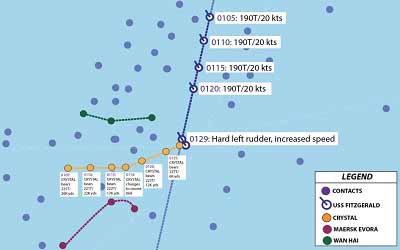What the commercial shipping industry can learn from the collision of the USS Fitzgerald and the ACX Crystal.
Lead your situational awareness

The USS Fitzgerald (F) collided with the container ship ACX Crystal (AC) on 17 June 2017 south west of Tokyo with the loss of seven lives. The duty officer was on watch. The two senior-most officers had gone to rest after a tiring day’s work.
Weather conditions were normal for that time of the night, through there was significant fishing and commercial traffic in the vicinity of the Fitzgerald. To cut a long story short, the collision regulations required F to keep clear of AC but it did not- mainly because the duty-officer on the F mistook the AC for a nearby ship which would pass clear. Having said that, the actions of AC also contributed to the casualty.

Image courtesy: Report on the Collision between USS Fitzgerald (DDG 62) and Motor Vessel ACX Crystal by the United States of America, Department of the Navy
Most navigators who have sailed through the Far-East waters know that it is a challenge to find a clear route through fishing boats and nets. A dense pack of fishing boats can clutter the radar screen, making it difficult to discern which target poses a risk of collision, and which does not. Fishing boats are known to change course and speed unpredictably, some even trying to pass in front of the larger ship. Some fishing-net buoys are not visible until very late. On the other hand, the halo from powerful fish-attractor halogen lamps can interfere with the navigator’s ability to see navigation lights of other ships close to, or beyond these lights. Navigating these waters requires a calm but responsive mind, good bridge equipment, a sharp lookout and an able helmsman. Navigators will need to constantly and rapidly process all this information and be ready to constantly alter course-speed to navigate through dense traffic.
It's easier said than done. Statistics show that around 1/3rd of all the total losses of ships have occurred in the Far-East. Some recent examples:
January 2018: The Iranian oil tanker Sanchi sank with the loss of 32 lives, also after a collision in this area.
May 2017: The USS Lake Champlain and the fishing vessel Nam Yang 502 collided in the Sea of Japan. The naval ship was unaware of the collision risk that the fishing vessel would pose on their new course.
October 2015: The fishing vessel Lurongyu 71108 sank after the collision with the tanker Clipper Quito and one of the five fishermen was missing- presumed died. A third of all casualties in Japanese waters is on fishing vessels and the most number of cases being collisions.
March 2014: The Beagle III collided with the Pegasus Prime at the entrance of Tokyo Bay, resulting in seven fatalities. The navigator on the Beagle III was not aware of the collision risk posed by the other ship.
These are issues of situational awareness. You cannot react to what you’re not aware of. To address this, Chapter-Ten in my book Golden Stripes- Leadership on the High Seas talks precisely about such scenarios and useful practical strategies. These include:
- Keep your attention despite clutter. This could have helped the navigator on the Fitzgerald spot the right target which posed a collision threat.
- Give ourselves time to process the information. Slowing down the ship could have allowed the navigators more time to assess the situation.
- Keep the mind on manual. Visual lookout and use of all available information can help in developing good situational awareness.
- Train your vision. This includes visualization techniques; for example, five minutes of preparation before the start of watch can help us build a mental picture of what ship traffic to expect and what actions may be required.
- Leaders even with expertise, need to be situationally aware at all times- to be able to get themselves and their teams to act proactively, or to respond effectively. Because ten minutes of inattention in open waters can create dangerous situations. In close waters, ten seconds of distraction is enough to cause an accident. A leader cannot allow the error of one moment to undo the work of their career, or the lives under their charge.


